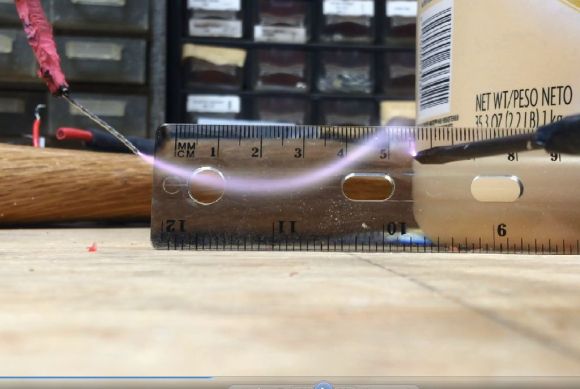
Let’s be honest. Playing with high voltage is awesome. Dangerous, but awesome — well, as long as you handle it properly. Flyback transformers are a great way to make a nice big electrical arc, but powering them isn’t that easy — or is it?
First off, for those that may not know, a flyback transformer is the type of transformer most commonly found in old TVs and CRT monitors. They typically can put out anywhere from 10kV to 50kV — the problem is, they aren’t that easy to power. Common methods include using a transistor style driver, or zero voltage switching (ZVS) — which is how [Skyy] cooked some s’mores at 50,000V.
As it turns out there’s another much easier and straight forward method. All you need is a fluorescent light ballast. Use the output on the ballast as the input on the primary winding of the flyback transformer — which can be found using a multimeter, just find the highest resistance between pins to identify it. Now because you’re working with such high voltages, you may want to insulate the flyback transformer by submerging it in mineral oil as to not short it out. That’s it.
Now it’s time to make some sparks.
If you want to get fancy, you can even control flyback transformers using an Arduino!















This guy is great! I love how knowledgeable and nonchalant he is.
My personal favorite is a modified PC power supply. Loads of power and very common. Mount that and a flyback on a plastic broomstick and you get a really nice way to kill weeds in your yard.
I haven’t read yet but as a guy who has built a few hundred watt SSTC and a flyback driver (as well as phase shifted pfc fullbridge 40v-400v converter) I have to say this is looking like a really good hack!
Try to harvest radio wave with it. 😁😁😁😁😁😁
Jacobs ladder it!!!
Two rods or stripped wires. Start at about 1/8″ apart. Then taper them out to about 3-4″ apart. HV to one lead, ground the other.
Lotsa fun!
How did you connect AC power to the flyback?
“just look for anything called a ballast. very old types done work, they use low frequency. so find a newerish kind.”
Heh. I’m not sure just any electronic ballast would work, surely some might balk at the unusual load (programmed start ballasts come to mind). Or be capable of rapidly burning out the flyback primary (you could wind a new one around the ferrite core if open-framed).
Pulling a ballast out of a spiral CFL might be a cheap and readily available option. Assuming they’ll stand up to the misuse, they’re not too well built.
You can also use the little backlight inverters to do things, I use one to drive a small voltage multiplier for a infrared image intensifier tube.
Fantastico!
I see an easy to make Home made Jacob’s ladder!
Old idea. [MikesElectricstuff] coined that idea first. http://youtu.be/O6_fa7ylXWA
I would recomend you to make a separate hole in the lid of your oil container for the high voltage output wire. I’ve seen a lot of 20kV marked wires arcing through the insulation at less than 10kV. All it takes is a small air bubble in the insulation…
I was thinking the same thing. Just about any voltage on the primary side will look like a good ground for 10’s of kV on the secondary.
Excellent presentation, but someone needs to tell him to hold the camera still. Moving it about the way he does induces nausea.
Where does one find a flyback these days? I think I have one somewhere in my basement; I scavenged it off an old black and white TV that was already old when I took it apart when I was a teenager back in the ’80s. It made a really cool arc — I don’t remember using a ballast, I think that I just used TV parts — I had no idea what I was doing back then, it’s a wonder I didn’t kill myself.
Not only playing with high voltage, but doing it in his socks.
Electricity will find it eases to travel from his feet to earth when not wearing any shoes.
“…primary winding of the flyback transformer — which can be found using a multimeter, just find the highest resistance between pins to identify it….” — I wonder is this right? Secondary should have the largest number of turns and highest resistance, not primary.
The secondary comes out of the top but it`s simpler to wind your own primary on the exposed leg of the ferrite anyways. If you are driving it with a square wave then it`s a good idea to close the air gap in the core
perfect for powering your “ion Breeze Enterprise” or “Lifter” projects.
wat is the wattage of the ballast uve used here? can i use a ballast of any wattage to power my flyback?
what about magnetic ballast ? could it drive the flyback ?
can you use this setup to do lichtenberg wood burning ?
Both your ballast and your transformer will be short lived, driving it this way. But still fun, nonetheless!